
The Blogsmith
Writing Style Guide
The Blogsmith Style Guide is the standard our writers and editors use to create and polish content for our clients. It takes some inspiration from AP Style, while expanding existing guidelines to apply more specifically to writing for global web audiences.
The Blogsmith Style Guide is free for all to use and we hope it helps you to effectively create content for humans and robots.
If you end up expanding it, we’d love to hear about the changes you’ve made — they might be useful to others hoping to improve their readers’ experiences!

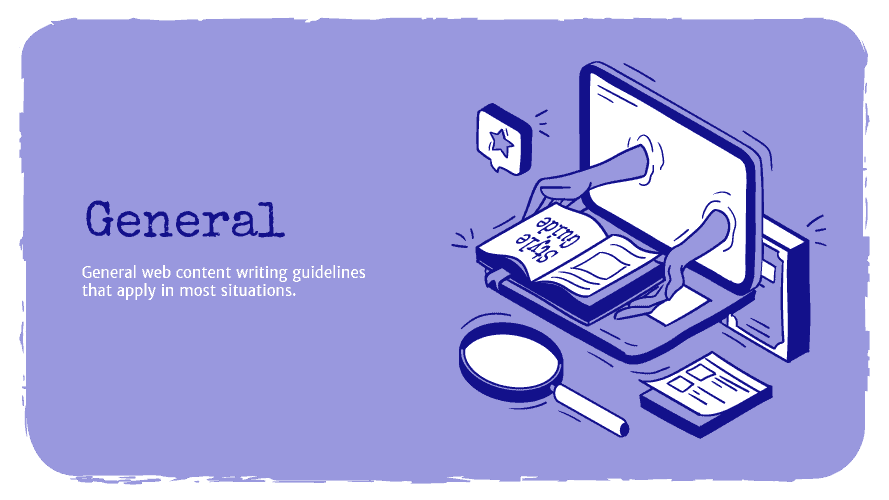
- Unless otherwise noted, articles should be a minimum of 1000 words.
- Don’t bury the lede. The direction of the sentence should be made clear ASAP, not after completely reading through to the end.
For example:
Don’t write this: “There’s a new way to accept payments, specifically for e-commerce and your WordPress website. If you use WooCommerce, you can benefit from WooCommerce payments. It’s just launched in 5 new countries.”
Write this instead: “WooCommerce Payments, an integrated payment solution for WooCommerce stores, is now available in five new countries. It can now be used by WooCommerce stores across Great Britain, Ireland, Australia, New Zealand, and Canada.”
- Avoid the obvious and make the next person’s job as easy as possible with quality information. If it doesn’t add value, cut it.
- If a sentence could be split into two sentences, do it. Shorter sentences are easier for reader comprehension. Run-on sentences are confusing.
- Use the Oxford comma. For example: item 1, item 2, and item 3.
- Speak in the second person: “you,” not “I, me, or they” unless otherwise instructed.
- If we’re writing for a client and the post is going on their website, don’t refer to them in the third person (for example, “the company”). It should be in first-person plural form when referring to themselves (for example, “our company,” “we,” “us,” etc.).
- Write with conviction: If you make a claim, don’t cast doubt or downplay it by using words such as “likely” or “maybe.” Own what you’re writing, or don’t write it at all.
- Avoid cliches and popular sayings — find a different way to say what you mean to say. Here are some common cliches and better alternatives:
- Instead of “word to the wise,” use “here’s what you need to know.”
- Instead of “can of worms,” use “problem.”
- Instead of “day in, day out,” use “every day.”
- Instead of “get your feet wet,” use “try.”
- Instead of “I beg to differ,” use “I disagree.”
- Instead of “like clockwork,” use “a habit.”
- Instead of “needless to say” use “that said.”
- Instead of “plain as day,” use “clear.”
- Instead of “scared to death,” use “terrified.”
- Instead of “time is of the essence,” use “there’s a looming deadline.”
- Instead of “wet behind the ears,” use “inexperienced.”
- Avoid abbreviations. For example, “veggies” should be “vegetables.”
- When using a standard abbreviation (e.g., “CTA”), make sure to define it the first time you use it in content (e.g., “call to action (CTA)”). There is no need to define it more than once in an article.
- If the definition is plural, make sure the abbreviation is also plural (e.g., “calls to action (CTAs)”).
- Avoid ending sentences with “etc.” Instead, just say “and” before the last list item. Precede the list with the word “including.” It implies there are more options and that the given items are just a few examples.
- Avoid using exclamation points unless absolutely necessary. Exclamation points can dull impact when overused and look unprofessional.
- Add a table of contents based on your H2 subheadings after your introduction. Choose an alternative phrase for “Table of Contents” (e.g., “What We’ll Cover” or “Here You’ll Learn” and link to each of your H2 subheadings.)

When creating a content table for a listicle, you may use the content table for more than alluding to the list items (e.g., [List Item] + [X use case compared to other list items with different strengths]) to make it more skimmable for the reader. Here’s an example.
- End the outline/article with a relevant call to action. For example: Get in touch, learn more, try a product, or tweet at @client’s Twitter handle.
- Use the conclusion of an outline/article to draw the topic back to the client and connect them in a relevant way.
- Never make assumptions about someone’s knowledge of a topic, even if something seems obvious to a certain target audience. Err on the side of over-explaining, with exceptions — we don’t need to explain basic financial concepts to an audience of CFOs.
- Don’t break the 4th wall: avoid referring to the article itself. Avoid saying “in this article” or “in this post.” If you’re writing a guide to a certain topic or process, you can use the word “guide” to refer to it.
- Be consistent. Make sure you don’t contradict the information provided in your articles.
For example:
If you make an absolute claim (such as “every business must get an EIN”), don’t talk about exceptions to your claim later on in the same article (such as a section about types of businesses that don’t need an EIN).
- Avoid tautologies. Don’t say the same thing twice in a sentence.
For example:
“Still, you should maintain a professional presence, regardless.”
It’s redundant to use both “still” and “regardless” — just use one of them.
- Match up your bullet points and headings. If your title or heading is about what to avoid, the subheadings shouldn’t be phrased as things you should do.
- Generally, it’s a good idea to avoid absolutes. Nothing is “perfect,” and usually, there are at least a few exceptions to every rule.
- Don’t start articles with a definition. Too many articles across the internet start with a heading such as “What Is ___?” or “What ___ Is.” Starting an article the same way makes our content feel unoriginal and formulaic. We make exceptions to target a featured snippet (read about featured snippet best practices) or client direction but aren’t afraid to push back.
- Even if you are writing an informational article, find another way to present an explanation of the concept. Fold definitions into other headings or the introduction. If you are creating a featured snippet, place it further down in the article. Most of the time, you can define a term that is the topic of the article in the introductory paragraphs before you even create your first subheading.
Alternative headings you can use to incorporate a definition of the key term are:
How ___ Works
Basics of ___
Why ___ Is Crucial
___ 101
Understanding ___
- Choose active voice over passive. Instead of something being done to a subject, the subject does something.
For example:
Don’t write this: “Users are given their choice of three plans.”
Write this instead: “The company gives users their choice of three plans.” or “Users choose from three plans.”
- Don’t break up your sentence’s flow unnecessarily.
For example:
Don’t write this: “There are plugins, for example, that can help.”
Write this instead: “For example, there are plugins that can help.”
- YOOTO: You only own things once. Take out extra “you/your” words to simplify a sentence.
For example:
Don’t write this: “You can give your prospects and your customers a warm welcome if you use emails.”
Write this instead: “You can give prospects and customers a warm welcome using emails.”
- We aim for a 7th/8th-grade reading level (measured by Grammarly/Clearscope) as it’s the most inclusive and understandable reading level for the internet layperson who’s trying to get answers to their questions quickly.
- Note: Clearscope data (on a topic-by-topic basis) may have a different target for the reading level.
- Check out these resources for writing plain English:
- The Plain Language Action and Information Network’s Simple Words and phrases
- Deanna Horton’s Handy list of human words
- Voice/tone spectrum: Consult The Four Dimensions of Tone of Voice:
- Funny vs. serious
- Formal vs. casual
- Respectful vs. irreverent
- Enthusiastic vs. matter-of-fact

Use this SEO checklist:
For all content:
- Make sure the SEO title fits the SERPs (50-60 characters)
- Add a meta description based on the keyword (under 155 characters)
- Don’t over-promise or make inaccurate claims. For example, an article with a short word count and only a few tips shouldn’t have a meta description that claims you’ll find “everything you need to know” about the topic.
- Write a separate page title option
- Add an introduction to the topic
- End with a short conclusion that has a call to action at the end based on the brand’s goals
- One (1) royalty-free feature image (with a link to the original source, unless it’s from the brand’s website)
- Supportive images every ~300 words
- Suggest alt text (written as ALT: Your text below the image source link) for every image, incorporating the primary keyword (while also describing the image) that could also be used as an image caption. The featured image’s alt text should be the SEO title. [Example]
Per 500 words of SEO content: (multiply by 2 for 1000 words, etc.)
- Target keyword used 2x+
- Target keyword used in the title and 1+ subheading
- Use secondary keyword 1+ times
- Use a secondary keyword in a subheading (if possible)
- 2+ internal links (The Blogsmith doesn’t link to the client’s homepage. The homepage is already the most linked page, so we try to add internal links to pages that are linked less often)
- 2+ external links to high quality/relevant sources
Other notes on keyword usage:
- If you’re using an awkward keyword, it’s OK to ditch articles (“a,” “the,” etc.) within the body copy but try to incorporate them in other key signal areas (title, URL slug, etc.).
- It’s OK to add simple words (“to” and “and”) in the middle of awkward keywords.
- It’s OK to use hyphens to make a keyword grammatically correct as long as the spacing between words is the same.
- It’s OK to use symbols as they are essentially ignored by Google. This includes registered trademarks such as ® and ™.
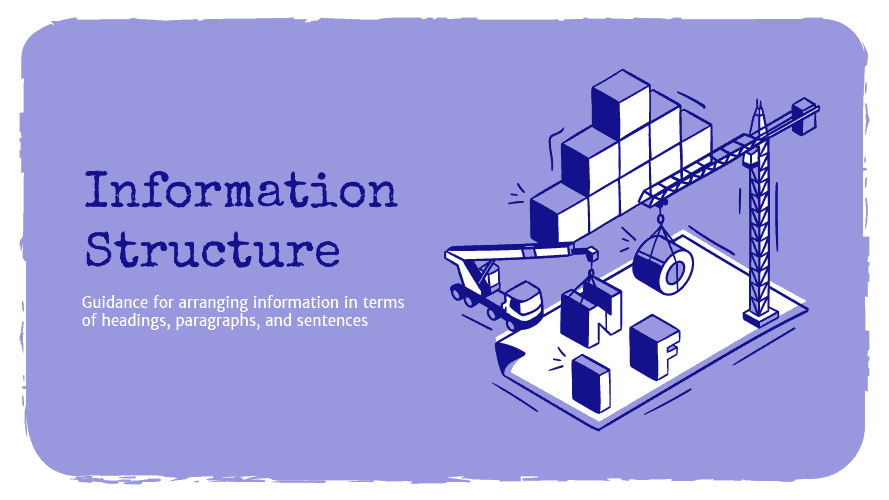
- BLUF (Bottom Line Up Front) — State the most important information at the beginning. Specifically:
- Start general.
- Then discuss details, conditions, exceptions, and secondary information.
- Divide your content into short logical sections:
- Try to limit paragraphs to three sentences. Shorter sentences and paragraphs are easier to read and comprehend online. Try to limit your paragraphs to three lines in Google Docs.
- Similarly, sentences should normally not take up more than two lines. If they’re longer than that, they’re too complicated.
Headings
- A well-organized document will still be difficult for users to follow if they can’t understand how it’s organized. An effective way to communicate structure to the reader is to use lots of useful headings, such as:
- Statement headings: Cover a specific topic and let the reader know what to expect.
- Question headings: If you know what questions your audience would ask.
- Use multi-level headings:
- Start with broad topic headings to organize a document, such as:
- How To Apply for an EIDL Loan Increase
- How To Apply for an EIDL Loan Increase
- Add specific topics to add a second level of organization, such as:
- How To Apply for a New Loan
- How To Apply for an Increased Loan
- How To Apply Through Email
- Required EIDL Loan Documents
- Start with broad topic headings to organize a document, such as:
Paragraphs
- Write short paragraphs.
- Focus on one idea/topic per paragraph.
- Use transition words to connect paragraphs.
Sentences
- Start with your main idea — not an exception.
- Keep it short — using lots of periods isn’t a bad thing.
- Express one idea per sentence. Long, complicated sentences suggest you are unsure what you want to say. Shorter sentences are also better for conveying complex information — breaking information up into smaller, easier-to-process units.
- Keep the subject, verb, and object physically close together. The natural word order of an English sentence is subject-verb-object. As you add modifiers, phrases, or clauses between two or all three of these essential parts, it becomes harder for the user to understand your message.
- Put long conditions after the main clause.
For example:
Don’t write this: “If you own a business with a low working capital ratio, look into working capital loans.”
Write this instead: “Look into working capital loans if you own a business with a low working capital ratio.”
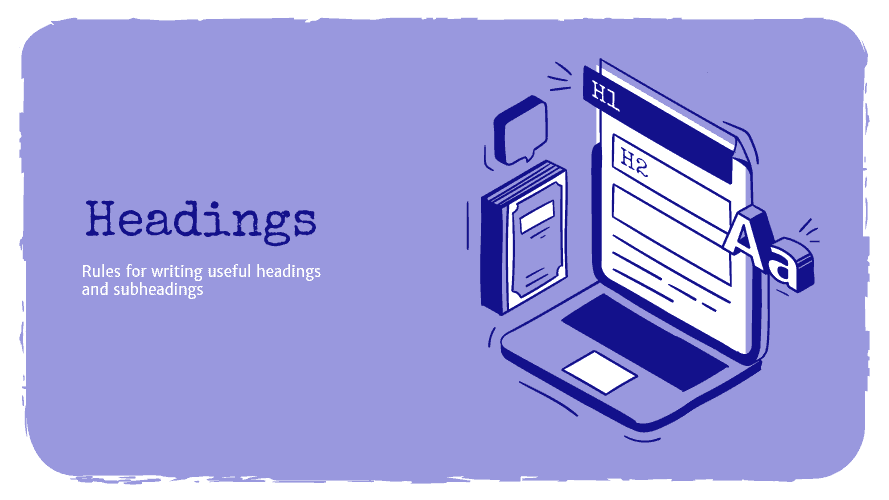
- Besides the title of an article, which should be Heading 1 (H1), subheadings should start with Heading 2 (H2), then Heading 3 (H3), and so on, as you add additional subheadings (and subheadings of subheadings).
- Avoid going higher than H3 in most cases. If you feel like you need to, it may be a sign that there’s a complementary topic to cover in a separate article.
- Make sure that headings are descriptive of the content they contain. One of their main purposes is to make it easy for people to skim, but we also want to use them to help Google understand context.
- Try to reinsert keywords in headings where possible. Try to make sure your headings can stand alone outside the context of the text they contain. For example, use “embrace employee engagement technology” instead of “embrace technology.”
- Use AP title case (unless otherwise noted by a client). The Title Case Converter tool can help.
- Don’t hyperlink text in headings. Find a better place within the body copy.
- Subheadings shouldn’t read like the start of an article within an article (e.g., “X Tips For [the subheading topic]”). It just feels weird, and most clients don’t like it. Try to avoid quantifying the contents of the section in a subheading.
- Avoid subheadings that take up more than one line. Aim to be concise so you don’t create a run-on sentence out of your subheading.
- Separate the conclusion with a subheading following this format: “Final Thoughts: [Article’s SEO Title]” — that helps us use the primary keyword again.
- Don’t use subheadings for short sections with fewer than two or three sentences worth of information. Use a bulleted list.
- Avoid phrasing headings as questions unless it’s to use a keyword.
- Include a paragraph of copy between headings. Before moving from H2 to H3, add some text to lead into the next heading.
- Front-load information and make it concise. Instead of “The Benefits of Email Automation,” try “Email Automation: Benefits.”
- Leverage your target audience’s FOMO (fear of missing out).
For example:
“7 Plugins To Make Your Website Stand Out From the Crowd” or “The 10 KPIs Every E-Commerce Business Needs To Know.”

- The text you link to should be descriptive of what you’re linking to. So don’t link “click here” anchor text. Instead, link copy that incorporates the name of the website or the specific page you’re linking to.
- Avoid linking more than five words together (and aim for fewer). Search engines see this as spammy, and it also hurts readability.
- Remove extraneous formatting (e.g., https://www.youtube.com/watch?time_continue=170&v=rQfPT3WgdOg&feature=emb_logo or UTM tags) when adding links.
- Don’t hyperlink punctuation (like quotation marks, commas, and question marks). In general, don’t do lazy link formatting that extends past relevant anchor text, including blank spaces.
- Don’t ever link to competitors. If it’s unclear whether or not they’re a competitor, assume they are. If there’s any doubt, leave a comment on the link for the editor to review.
- Don’t link to keyword competitors. Avoid linking anchor text that competes with target keywords (whether it’s an internal or external source).
- Don’t link to Wikipedia or other sites where users can edit published information (Wikipedia images are OK to use if no others can be found or created by our graphic design agency).
- Don’t link to Business2Community or other content syndication sites. Make sure to link to the original article/source.
- Add comments to suggest links for related articles that have been written but aren’t published yet.
- Add external links to define concepts that are obscure but not relevant enough to expand on in the article.
- Use bold formatting and a separate line of text to call out to anything more than a link. For example, if you are linking to a downloadable white paper, e-book, webinar, etc. Other links should be referenced in-line unless there’s a good reason to call them out separately.
- Example: https://share.blgsmth.tips/RBun8N7W
- When choosing between a direct link to a PDF or the landing page where you can access it from (gated or not), link to the landing page.
- Don’t link to articles that are very similar to the article you’re writing. External links should enhance your article, not act as a substitute.
- Choose words that are likely to be keywords for the article you are linking to. If you are linking to an article about the best WordPress plugins for e-commerce, then “best WordPress plugins for e-commerce” is most likely the best text for a link in your article.
- If you’re using the same source to back two or more points in an article, make sure to highlight the information relevant to the source with a comment.
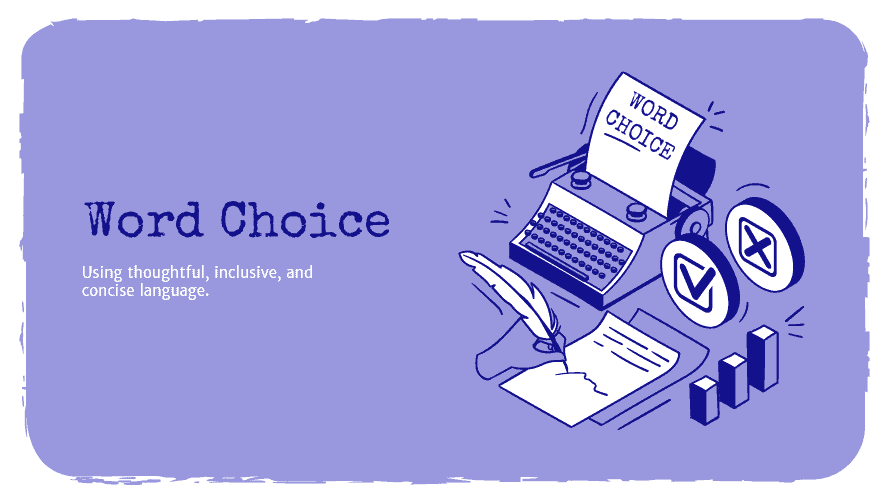
Jump to Tone Guidelines for more word choice guidelines around tone >>
- If you’re referring to a brand, restate the brand name for every paragraph they’re mentioned (not “it”). Repeat the proper noun/noun of whatever you’re referring to if it sounds weird in a sentence out of context.
- If you’re referring to a company, it is a thing rather than a person.
For example:
Don’t write this: “the company who”
Write this instead: “the company that”
- A “from” needs a “to.” No exceptions, not even when writing the time of an event.
For example:
“They have articles about topics ranging from digital marketing to famous tech geniuses in history.”
The items on either end of “from” and “to” should be extremely different. Otherwise, you’re just listing examples.
- Related — don’t leave room for ambiguity when referencing different concepts. Instead of a sentence like “how do you do it?,” fill in the blank. “What is it?” Take this opportunity to add the keyword or a related keyword, if possible.
- Other examples of ambiguity:
- “Many” is less clear than “50%” or even “the majority.”
- When you use a number, tell the reader how many of what.
- Instead of saying, “many people love this product,” take the opportunity to prove it by citing a customer review.
- Instead of saying “see how things are going,” be specific about what those “things” are.
- When making any comparison, be clear about what you’re comparing to.
- Other examples of ambiguity:
For example:
“Most e-commerce businesses have to process much more data through their website” add: “than a standard business website.”
- Besides complex industry-specific words that you can’t avoid without losing meaning, write with uncomplicated language. Assume middle school level reading comprehension.
- Don’t repeat the same words too closely together in the same sentence or paragraph.
- Don’t use -ing suffixes together.
For example:
Don’t write this: “involving throwing”
Write this instead: “that involved throwing”
- Choose phrasing that avoids the -ing suffix wherever possible. Typically, the -ing suffix should only be used as a verb within a sentence and not as a noun. It tends to make sentences weaker, confusing, and/or more wordy than necessary.
For example:
Don’t write this: “Creating SEO content is crucial to building a successful website.”
Write this instead: “SEO content is crucial to a successful website.” or “Create SEO content to build a successful website.”
- In headings, use “advantages” and “disadvantages” rather than “pros” and “cons.”
- Avoid using words that might insult the reader’s intelligence. We’re trying to educate people, so don’t assume anything is obvious. Avoid phrases like “obviously,” “of course,” “clearly,” and “everyone knows.”
- When to use “e.g.,” versus “i.e.,”: These terms aren’t “e.g.,” means “for example,” whereas “i.e.,” means “that is to say.” Both “i.e.,” and “e.g.,” always include a comma, per AP style.
- You can use “g.,” anywhere you would use “for example.”
- You can use “e.,” where you would use “that is to say” or “in other words.”
- Note that both “e.g,” and “i.e.,” are usually used within parentheses.
For example:
“Try a plugin (e.g., Yoast or Rank Math) to enhance your website’s SEO performance.”
“Tools like Yoast and Rank Math (i.e., SEO-enhancing plugins) are extremely handy.”
Inclusive Language: Basic Guidelines
- As stated earlier, we aim for a 7th/8th-grade reading level (measured by Grammarly) as it’s the most inclusive and understandable reading level for the internet layperson who’s trying to get answers to their questions quickly.
- Check out these resources for writing plain English:
- The Plain Language Action and Information Network’s Simple Words and phrases
- Deanna Horton’s Handy list of human words
- Check out these resources for writing plain English:
- Default to gender-neutral language. Instead of “his or her” or “she or he,” just say “theirs” or “they.”
- Use people-first language. For example, “a person who is deaf” instead of “deaf person.”
- That may not come up often, but it’s incredibly important for certain clients we work with — particularly the health care sector.
- Use approachable language that doesn’t unintentionally alienate.
- Some words to avoid and what to use instead:
- Avoid “old” — try “a person who is aging/older.”
- Avoid “boyfriend/girlfriend” — try “partner.”
- Avoid “homeless” — try “person experiencing homelessness.”
- Avoid “accused” — try “reported.”
- When dealing with sensitive topics — such as violence or racism — consider this suggested language list.
- For more guidelines, check out The Blogsmith’s Inclusive and Plain Language Style Guide.
Words/Phrases To Avoid
- Don’t use “ones” to describe a noun you’ve already defined. Use the same word again or find another way to say it.
For example:
“During the interview process, be sure to ask the right questions. This could be a mix of common restaurant job interview questions and ones (try “those”) that are more unique to your company’s culture.”
- “Utilize” — go with “use.”
- “Aside from” — go with “besides.”
- “Host” — go with “a variety,” “a number of,” or “suite.”
- “COVID-19” — Go with “the pandemic.” “COVID-19” is reserved for public health information and may hurt ranking in our articles that aren’t strictly about that topic.
- “Allow” — go with something less passive, like “empower,” “assist,” “enable,” “grant,” or “permit.”
- “Cheap” — go with variations on “affordable.”
- “Thing” — go with something more descriptive and specific.
- “Because” and “because of” — go with “since” or “due to.”
- Note: Both “because” and “since” can be used as causal conjunctions (to show cause). As “since” has fewer syllables, we recommend using “since” over “because.” However, “since” also conveys how much time has passed, so use “because” if the context is unclear or absent.
- “A lot” — Go with something more specific, or a word like “myriad” (just “myriad,” not “a myriad of”).
Correct Spellings for Words
- Use “e-commerce,” per AP Style guide rules. They treat (most) other e-words the same (like “e-book” — but “email” doesn’t have a hyphen). For capitalizations, “E-commerce.”
- Use “startup,” not “start-up.”
- Use “non-profit,” not “nonprofit.”
- “Livestream” is one word in all cases, per AP Style guidelines.
- “Website,” not “site.”
- “Webpage,” not “web page.”
- “Shortlink,” not “short link.”
- Per AP Style guide rules, “internet” isn’t capitalized. Likewise for “intranet.”
- “Call-to-action” when it’s a modifier (“call-to-action button”), “call to action” in other usages. “Calls to action” when pluralized.
For example:
“Make sure your content includes an appropriate call to action.”
“Calls to action are essential for content.”
- Abbreviations should be in all caps, such as “CAPTCHA.”
- Capitalize heading types when referencing them (H1, Heading 1, H2, Heading 2, and so on).
- In general, if you’re unsure about correct usage, go with AP Style.
Other Word Choice Guidelines
Writing about WordPress:
- Paid products (themes, plugins, etc.) are usually referred to as “premium.”
- A tool is integrated with (not into) another tool.
Writing about SEO:
- Avoid absolutes unless you have a cited, very high-quality source for proof. We don’t know everything about Google’s algorithm — most of the time, we’re guessing.
- Incorporate the adjective “relevant” when you talk about ranking in search. Websites shouldn’t want to come up in every search, just those they’re optimizing for.
- Give a specific definition so writers know which aspect of the multifaceted concept you’re referring to.
For example:
“Enhance SEO performance”
- Using the possessive:
- If the word is pluralized and ends in an “s,” put the apostrophe at the end.
For example:
“those businesses’ strategies”
If the word is singular and ends in an “s,” add an apostrophe and an additional “s.”
For example:
“that business’s strategy”
- Always choose positive language when referring to clients. Avoid phrasing that could be interpreted negatively, even subtly, or unintentionally. Spin limitations positively.
For example:
Don’t write this: “Previously only available in the U.S.”
Write this instead: “Available in the U.S. at launch.”
- Choose positive language about features. Say what something is or does instead of what it isn’t or doesn’t do.
For example:
Don’t write this: “The brand doesn’t offer hosting for websites that aren’t on WordPress.”
Write this instead: “The brand offers hosting for everyone that uses WordPress.”
Replace “not” words (such as “can’t,” “shouldn’t,” “don’t,”) with a stronger verb.
- Write with authority. If you’re giving readers advice, tell them rather than suggest to them. There are some exceptions (like when you are genuinely offering multiple options), but in general, choose strong, authoritative language.
For example:
Don’t write this: “You can add keywords to improve your content’s SEO.”
Write this instead: “Add keywords to improve your content’s SEO.”
Be Concise
- Use as few words as possible. Aim for “concise.” For example, instead of “more and more” just go with “more.”
- Avoid redundancy. This pertains to common redundant phrases (e.g., “my own,” “various options,” “simple and straightforward”) and your sentences. Read through your work to make sure you aren’t repeating the same idea with a different sentence structure. If there are sentences with similar ideas but slight variations, see if you can condense them into one clearer sentence.
- Be careful of extraneous glue words. These words string together the adjectives, nouns, and verbs in a sentence. Use as few as possible.
For example:
Don’t write this: “There will be a button on the webpage on the left side of the screen you can click on.”
Write this instead: “Click the button on the webpage’s left side.”
- Cut out fluff words. These words don’t add value or can be removed without changing meaning. Examples include:
- “That” — Instead of, “They say that it’s better,” choose, “They say it’s better.”
- “Simply” or “just” — Instead of “Simply open the app,” choose “Open the app.”
- “However” and “so” — These words can be useful but are often unnecessary. Ask yourself if you need it or if your sentence makes sense without it.
- “Thankfully,” “fortunately,” “luckily,” “actually,” “in other words,” or “of course” — These words don’t add value. Try a bucket brigade like “Here’s the good news:”
- “In order to” — Choose “to” instead.
- “Start to” — Instead of “Start to think about your marketing strategy,” choose “Think about your marketing strategy.”
- “Very” or “really” — Choose a single, better adjective or verb.
- Choose strong verbs instead of adverbs. Rather than modifying a common verb or adjective, choose a less common option that better conveys your intention in a stronger, single word. Instead of “We’re very excited,” say, “We’re thrilled.”
- Cut prepositions when possible (“to,” “in,” “for,” “of.”). One way is to make something possessive (e.g., Instead of “the profile of the user,” choose “the user’s profile.”).
- Avoid “there is/are” at the start of sentences. Often, it’s unnecessary, becomes repetitive, or is already implied. (e.g., Instead of “There are many changes you can make to your template,” choose “Customize the template any way you like.”)
- Remove excess punctuation. As a general rule, if you need more than three punctuation marks in your sentence, it’s better to break it up instead.
- Try to use short, simple words: (cheat sheet)
- Prefer the familiar word to the far-fetched.
- Prefer the concrete word to the abstraction.
- Prefer the short word to the long.
- Avoid hidden verbs:
- Use the strongest, most direct form of the verb possible.
Verbs are the fuel of writing. Verbs give your sentences power and direction. They enliven your writing and make it more interesting. Too often, we hide verbs by turning them into nouns, making them less effective, and using more words than we need.
- Use the strongest, most direct form of the verb possible.
For example:
Don’t write this: “To develop an understanding of the issue, we need to do an analysis of the complete situation.”
Write this instead: “To understand the issue, we need to analyze the complete situation.”
Don’t write this: “Boiler worker safety protection procedures development.”
Write this instead: “Developing procedures to protect the safety of boiler workers.”
- Use the simplest form of a verb — present tense. Try to use as much present tense as possible.
For example:
Don’t write this: “The listed sections describe the information you would need to satisfy the scholarship requirements.”
Write this instead: “These sections tell you how to meet the scholarship requirements.”

Using Conversational Language
Some clients require us to write using a conversational tone. Here’s how:
Imagine you’re on a tower seeing a show from a distance. And you have your friends — the audience — on the ground. Write/narrate in a way that your friends on the ground can visualize whatever is happening in the show:
- Be precise.
- Use simple words and short sentences.
- Avoid using jargon.
- Vary the length of sentences and paragraphs to keep the narration interesting.
- Use “you” instead of third-person language.
- Use examples your readers can visualize.
- Use contractions (for example, “it’s” instead of “it is,” etc.) and active voice (for example, “they created the product” instead of “the product was created by them”).
- Show emotion and understanding. Show you understand your target audience’s pain points and challenges.
- Ask the reader questions (for example, “Sounds tough, right? But it doesn’t have to be.”).
- Break grammar “rules” to sound more natural. It’s OK to:
- End sentences with prepositions.
- Begin sentences with “or,” “and,” or “but.”
- Use sentence fragments.
- Use slang sparingly.
Check out Chapter 3 of Writing for Humans and Robots for more info.
- Read your content out loud and rewrite it if it sounds like “writing.”
- Copyblogger offers a good resource for more info >>

- Spell out numbers nine and under within the body copy (even if they refer to larger numbers: “three million” — not “3 million”). Numbers 10 and above should use numbers instead of letters.
- ALWAYS use numbers instead of letters in headings.
- For a numeric sequence/range that consists of a number below 10 and a number over 10, use numbers (e.g., 7-11).
- For repetitive numeric sequences/ranges in the same article or in a list, use numbers (e.g., “1-2 posts,” “2-3 tweets”).
- For money, use numbers and the dollar sign (e.g., “$6,” “$1 million”). For cents, spell out the word (e.g., “5 cents”).
- Use % for percentages unless otherwise specified by the client.
- Avoid ambiguity. If you write a number, make sure you say what the thing you’re numbering is, even if it is already implied (e.g., “Limit is 300 emails”).
- When writing dates, abbreviate the month for a specific date (e.g., “ 26, 2020”). Write the full month when referring to a month and year (e.g., “November 2020”).

- BE CONSISTENT. If you start a list and end each point with a period, make sure all list items reflect this — also known as parallelism.
- Similarly, if you capitalize one type of element, you need to capitalize all other types of that element.
- If you’re writing a listicle, make sure that each subheading is numbered such that: 1. [List Item Name]. Note that it shouldn’t turn into a formatted ordered list (with indentations) as a result of this formatting.
- Make sure all fonts are consistent (Arial), and that all body text is the same font size (11pt). Your document should follow the same formatting as the blog post template.
- Put punctuation (periods, commas, question marks, exclamation points) within quotations. For example, “So and so said, ‘blah blah blah.’” Conversely, place punctuation outside of parentheses—except if it’s part of the text, like question marks or exclamation points.
- Add a space after an ellipsis.
- When creating space for emphasis, don’t use a dash or double dash. Use the em dash: — (you can create on Mac with control + option + -)
- Limit the frequency of em dashes next to each other and other repetitive formatting that leads to compound sentences (:, multiple commas, and so on). Too much of the same type of formatting close together looks sloppy. That is also true of similar repeated formatting in the same sentence
For example:
Don’t write this: “By combining Leadfeeder—which allows you to see which companies visited your site—and the Sales Navigator—which also shows you contacts from within the company—you can conduct more specific targeting.”
Write this instead: “By combining Leadfeeder (which allows you to see which companies visited your site), and the Sales Navigator (which also shows you contacts from within the company), you can conduct more specific targeting.”
- Limit the frequency of commas next to each other.
For example:
Don’t write this: “He listed the qualities, like intelligence, humor, conservatism, and independence, that he liked in an executive.”
Write this instead: “He listed the qualities — intelligence, humor, conservatism, independence — that he liked in an executive.”
- When using abbreviations, make sure that you’ve defined the full phrase alongside the abbreviation before referring to the abbreviation alone (yes, even for abbreviations that the target audience should know, with few client exceptions).
- The correct capitalization and spacing of a brand’s name are important to the people we write for, so double-check that you have it right. Reference their website, footer text, and social media accounts if it seems ambiguous. In general, match the proper capitalization rules for any mention of brand names.
For example:
It’s WordPress — not Wordpress. Besides within text, follow this rule when sharing a URL as text (WordPress.com, not Wordpress.com).
- If you use a text decoration (bold, italics, underline, etc.), don’t extend the formatting to punctuation: semi-colons, periods, and commas.
- DO use text decorations (bold, italics, underline, etc.) to call out stand-out facts within your articles.
For example:
“Text messages are not more secure than emails.”
- When referring to user interface (UI) elements, such as a menu or tab in the WordPress dashboard, bold mentions of UI elements — but not the generic labels that describe them (menu, tab). Don’t use quotes.
For example:
“In your WordPress dashboard, click on WooCommerce > Settings > Shipping tab > Leave At Door.”
- Use bold formatting for the titles of a company’s proprietary products rather than quotes.
For example:
Instagram offers immersive experiences through Collections.
- Add bold formatting to any word, phrase, acronym, or concept when you define it.
- Use parentheses sparingly as they can take away from the main point. If a parenthesis is closer to a full sentence, make it a sentence instead.
- Only use parentheses for non-essential information that can be left out without changing a sentence’s meaning.
- Use bucket brigades where possible to keep people reading. Put the bucket brigade on its own line with white space above and below it.
For example:
“Having trouble driving traffic to your website?
Here’s the good news:
Our guide offers eight simple, actionable steps you can take to boost your website’s visitor count.”

- Use bullet points whenever possible to create white space and break up information.
- Bullet points and numbered lists are the only types of formatting we use for adding lists to content. Do not use dashes or other list formatting unless there’s a good reason.
- If you ask more than two questions in a row, make the list of questions a bullet list.
- Ensure parallelism/consistency between all points in a list AND all bullet point lists on a document (do they all start a certain way? are they full sentences or fragments?).
- Capitalize the first word following the dash or bullet.
- If items on a list are full sentences, punctuate them as such. Otherwise, do not use punctuation. This should be your only deviation from parallelism between a document’s separate bulleted lists.
- Use colons to separate labels from explanations (like if you were defining a term, such that — [term: long description]). Add bold formatting to the label/phrase.
- For sentences with a colon preceding a bullet list, give them their own paragraph to create white space.
- If a bullet list exceeds five items, consider regrouping information as separate bullet point lists under related categories.
- Don’t use bullets for one or two items (exception: unless it’s in the bullet list introducing an article’s content).
- Add a sentence before your bulleted list that explains/introduces it. Use a blank space (hard return) above and below this intro sentence that separates it from the list and previous paragraph.
Exception: Do not add a blank space if a heading precedes the sentence introducing the bulleted list, as in featured snippets.

- If using a direct quote, attribute with a name and link to the source of the quote.
- When quoting a study, lead with the name of the study (with a link using the study or organization’s name as the only link anchor text), and the year of the study, then share the resulting stat. It helps people understand the credibility of what they’re about to read and benchmark it in time.
For example:
“A 2019 study conducted by Chase Bank found that 26% of students have credit cards.”
- When citing statistics, link to the original study, not the article where you found the information, whenever possible.
- Make sure statistics are relatively current. Don’t cite studies from more than three years ago without justification. If you’re citing a technology stat, the information should be current within 1-2 years.
- There are exceptions for certain topics and industries. For example, older psychological experiments are OK to cite if there hasn’t been a more recent study that challenges the results in a meaningful way.
- When searching for stats, sort by past year. In Google, click Tools > Any time > then switch to Past year.
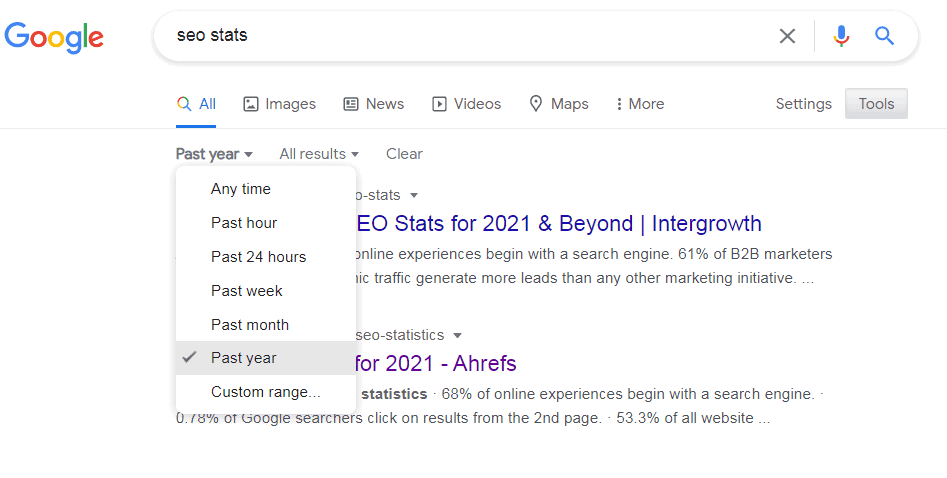
- If you’re debating whether a stat is relevant or legitimate, find the study’s details, such as the number of participants and their occupation. Incorporate this information in your article when relevant (e.g., “[x company’s] survey of 500 e-commerce store owners found [stats].”)
- When citing an article title, it should be in italics.
- If you’re sharing an example, make sure it isn’t unintentionally plagiarized from your source material. Make up a completely new example.
- If you’re quoting a website, not a person (except if it’s a definition of a concept), paraphrase the information. We can’t quote direct web copy — it’s a duplicate content.
- If you’re quoting an online review, cite the person you’re quoting on a separate line with a hyphen.
For example:
– Tom M., June 2020
- When sharing an example to illustrate a point, make sure it’s relevant to the industry/topic.
For example (from an article about “top of funnel content for injury firms”):
Don’t write this: “Say you’re not sure about the differences between a road bike and a commuter bike, so you find a helpful article explaining the key differences. It means you’re likely interested in buying a bike in the future if you’re curious about the specifics.
When you later search a more transactional term like ‘Best city bikes,’ you’re more likely to click on a link or directly turn to the website you previously visited because of the pre-established level of trust.”
Write this instead: “Say a cautious driver has just moved to your city. They’re unfamiliar with roads, so they look up the dangerous intersections they should avoid. And they stumble upon your top-of-funnel article that compiles the places around town where the most crashes occur.
Now, they’re aware of your firm and the idea of personal injury lawyers. If they’re ever in an accident in the future, they will likely use your website as a trusted resource and choose you for assistance.”
The content will be a bit different for a personal injury firm, but the concept will remain the same
- When talking about time, define it. Don’t refer to “this year” (what does that mean a year from now?) — say “in 2022,” even if it’s referring to the current year.
- Similarly, say “since 2020” instead of “in the past 18 months.” It helps craft evergreen content.

- Come up with a relevant topic for questions you can ask subject matter experts (SMEs) that would be both relevant and interesting for your target audience.
- Plan due dates around the fact that it may take several days to get expert responses.You can find SMEs through:
- You can find SMEs through:
- HARO (guidelines below)
- Client/company networks
How To Submit a HARO Query
- Start with a clear query title that gets to the point. The reader shouldn’t have to read the entire query to understand if it is relevant to them.
- Write a query designed to answer important questions. Your query should pose several specific questions that add value to your article. What would a reader want to know about the subject—especially if they had a chance to go through a Q&A session with experts? Ask questions on behalf of the reader’s best interests. The Blogsmith recommends writers make some questions required and others optional to increase the likelihood of getting good responses.
- Qualify responses with requirements. If you don’t add qualifiers (e.g., must have been in business 10 years, must be earning $10,000 per month, must have a degree in business), then you’re going to get many unqualified responses to weed through. Set requirements appropriate for the topic.
For a more in-depth step-by-step tutorial, follow The Blogsmith’s HARO submission process guidelines.
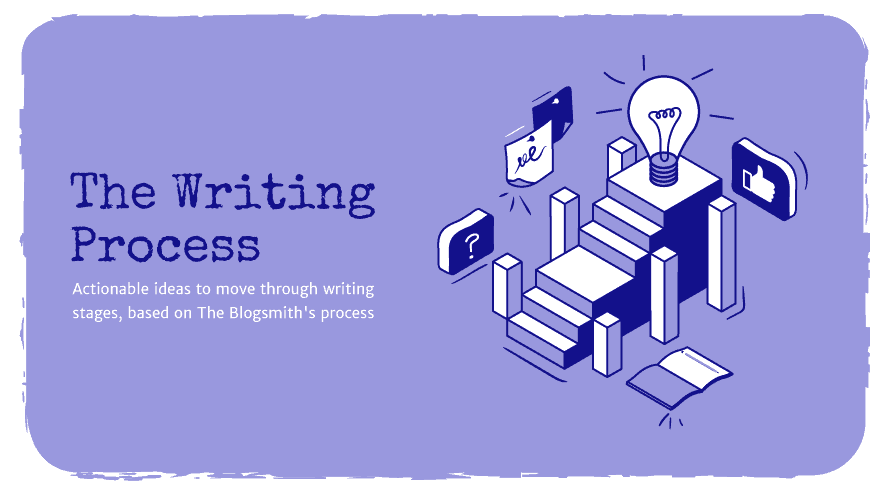
Here are some important details about the writing process:
Outlines
For you, the writer, the writing process starts with an outline. The purpose should be to capture the client’s goals and develop the outline ideas as much as possible to save time on the drafting stage — within the client’s set word count.
We highly encourage you to include internal and external sources in your outline to avoid sudden idea and intent shifts in the drafting stage.
And remember, whether you’re speaking to businesses or individuals, pain-point-driven arguments are always better. Pain points are key for outlining stories that show relatability and engage readers.
For an in-depth view of the storytelling elements you can implement as early as the outlining stage, check out Chapter 18 of Writing for Humans and Robots.
Writing the Draft and Self-Editing
Drafting and self-editing go together. As the writer, your primary goal should be ensuring that the ideas you’re developing are consistent with what was shown in the outline. Nobody likes surprises.
To achieve that, we suggest using the following self-editing passes on your drafted content:

You should also perform a sixth pass to determine if you implemented the keywords correctly. Yes, you should always optimize to reach our optimization goals. But never, and we mean never, compromise readability in exchange for incorporating more keywords.
Note: Whether you apply the multi-pass technique after finishing each section or the entire draft is up to you. However, the first is better for achieving consistency than the latter.
Consult Chapter 16 in Writing for Humans and Robots for more writing and editing guidelines.
Fact-Checking
We can’t get away with writing whatever we want. While it’s true you can likely find any source to justify any point on the internet, that’s not how The Blogsmith rolls.
Here are some general guidelines to avoid source-related problems throughout the research, outline, and draft stages:
- As a general rule, aim to over-attribute — every fact should have a source.
- Do your part to validate any facts or statements you share in your content. If you can’t, remove it.
- The validation process should involve:
- Avoiding assumptions.
- Proving the quoted stat or statement with the original source.
- In many cases, finding the original source may require extra research. If you can’t, find other sources (while avoiding competitors) or scrap the argument altogether.
- Ensuring the information provided by the source is true or at least matches the overall sentiment of other trusted sources.
- If a statement smells funny, it’s probably gone bad. Don’t settle for the first thing you find.
- If statements smell funny, you can probably imagine how misspelled company names smell. HushPot isn’t the reliable CRM provider you’re looking for, but depending on your interests…
- If statements smell funny, you can probably imagine how misspelled company names smell. HushPot isn’t the reliable CRM provider you’re looking for, but depending on your interests…
- The more authoritative a website is, the better.
- Consider resources such as Statista.com or Data.gov. From there, create a list of credible statistics databases based on the nature of the content you’re creating and the industry you’re operating in.
- If a statement smells funny, it’s probably gone bad. Don’t settle for the first thing you find.
- Checking the date of the publication. In SaaS, marketing, and other industries/topics we cover, processes can change quickly. Keep your sources recent (no more than one or [preferably not] two years old).
- Checking for biases. Bias isn’t just tied to politics or other often-deemed controversial topics. Many things can affect how potential sources think, approach, and say things online.
- If the source is biased, mention it in the article.
- Try your best not to perpetuate any train of thought that might oppose the client’s — it’s easier just to be bias-free.
- Click-bait is usually a bad sign.
- Using tools like Nobias to complement your feelings about how sources cover specific topics.
For more in-depth tips on fact-checking and verifying domain authority, reference Chapter 17 of our book.
Calls to Action
No content is complete without a compelling and connecting call to action (CTA). You should write CTAs that complement the article’s content and convey the client’s goal.
CTAs should be clear, compelling, tied to the audience’s expectations, and focused on one specific goal. Reference Chapter 19 of Writing for Humans and Robots for more details on how to write better CTAs.

There is no situation in which duplicate content is OK, save for explicit directions from a client to duplicate their existing content in another place. Even so, duplicate content should be accompanied by a comment with more details.
- Writers: To avoid any chance of your article looking anything like source materials, follow these steps:
- Rearrange section headings so they’re not in the same order.
- Throw in additional new section headings while getting rid of others that closely mirror the original source material to add a fresh perspective.
- Use completely different sections or takeaways.
- Share fresh examples and insights exclusive to your content.
- Include a list of all sources referenced at the top of the article document. Include sources you used to help create content, even if you didn’t explicitly link to them.
- Editors: Run the text through Grammarly or Copyscape and make sure that there are no instances where the text is too similar to other online articles.
- Go through the top three most relevant Google search results for our primary keyword (or article topic/title) and compare the complete blog article to competitor articles for possible plagiarism.

- Find a relevant featured image for every article unless otherwise communicated.
- Use at least one image within the text (ideally more) to illustrate concepts (do not incorporate generic stock photos that don’t add anything). Include source URLs when relevant.
- When embedding YouTube videos, add the CTA embed: before the link. When embedding long codes (like an embedded Instagram post), simply insert the CTA embed: and add the code for the embeddable asset as a comment. Regardless of what you’re embedding, refer to it on its own line (not as part of another paragraph).
- When using images within text, they should be inserted after a subheading (not preceding it) and referenced right where they’re being discussed (like right before or after the text that refers to it, depending on the context of the text).
- Connect images to the subheadings. Images tell a story and are a powerful way to catch a reader’s attention.
- Make sure that images are high-resolution — no fuzziness.
- Make sure that images are free and legal to use.
- Images should be relevant to the article, not just vaguely related.
- You do not have to include a link to the image source if it comes from the client’s website or files.
- No need to add a source for screenshots, but you can specify it as a “Screenshot” just below the image. Format it in title case and italicized,
For example: Screenshot - Use inline images. Don’t align them to the center, right, or left of the text.
- Submit tables to Easelly or Design Pickle. If you make a table to explain anything in your article, submit a request to Easelly or Design Pickle to make it a shareable infographic. Give Easelly or Design Pickle style guidance (at minimum, a link to the client’s website), and instructions to make it in a shareable format, so the information can stand alone from the article.
- Submit infographics to Easelly. Unless the information is proprietary, it’s better to create our own version which uses the client’s brand as a reference point.
- Include pull/block quotes once per 1,000 words.
- Add alt text for images (written as ALT: Your text below the image source link). Incorporate the keyword where possible and keep it under 125 characters.
Include image licensing details in the Image Source line (basically, if you use an image from a stock photo website, confirm that we have the license to use it).

Image Source (License: Adobe Stock standard license)
ALT: Your alt text here
- Crop screenshots from the WordPress Plugin Directory as such:

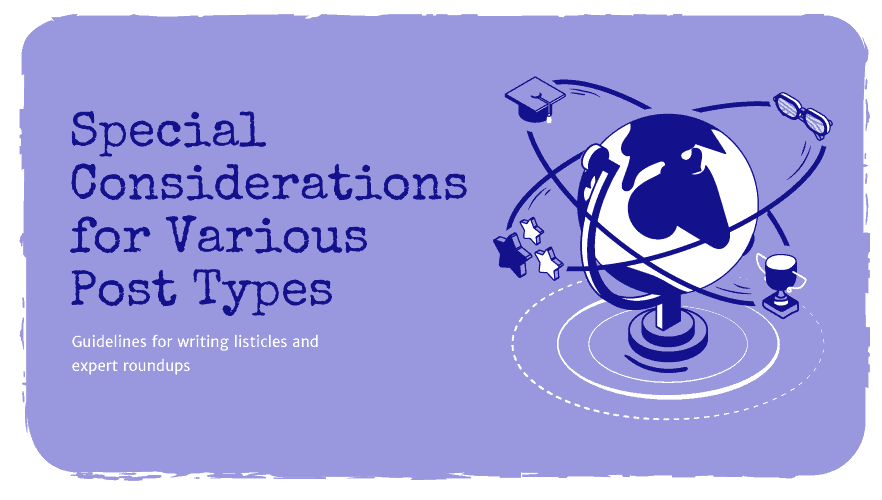
Listicles
When creating articles that include or are based on product comparisons, use the following format (in order):
- Name of the product
- Screenshot of the product
- Tool description/USP (unique selling proposition)
- An at-a-glance bullet list of tool features
- Best [keyword] for: specific use case
- Price
- When talking about pricing, use the following template, mentioning/omitting free plans and special annual pricing when applicable (if there are only yearly plans, use $x/year instead of month):
[Free (with limited features).] Premium plans start at $x/month [when billed annually].
- If there’s a specific plan that our target reader would benefit from based on mentioned features, mention it in the body copy.
You don’t have to add an image source link for the screenshot. However, make sure you link to the company website the first time you use the company name in the tool description.
Any WordPress plugins you include in your list should tick the following boxes:
- Has been updated within the last three months
- Has 2,000+ downloads/active installations (for niche topics — ideally 10,000+ for popular topics)
- Has mostly 5-star reviews
- Has 100+ reviews
You should also do a Google search to scan other reviews/news items about your topic.
Listicle example by The Blogsmith >>
When creating listicles of a more short-form nature, a shorter tool description/USP summary can replace the bullet list of features and “best” for section.
Expert Roundups
- As with sourcing expert quotes, come up with a relevant topic — a question we can pose to experts that’s relevant to the client’s audience, and that would be interesting to read about.
- Ping your editor or content manager to approve the roundup topic as soon as the article is assigned. It will take several days to get expert responses.
- Follow The Blogsmith’s HARO query submission process to submit your question for consideration on HARO and get expert responses we can quote in the article.
- Make sure to include all relevant information/files (like contributing experts’ headshots) when delivering a final content asset.
How to write great expert roundups:
Structure:
- Pick your best expert insights to whatever question(s) you asked.
- Look for patterns in terms of recurring topics that keep coming up and are compelling to talk about — those are your subheadings.
- Within each subheading, interject experts’ quotes with takeaways and other relevant commentary (like statistics) so that there’s more commentary than quotes.
Examples:



















